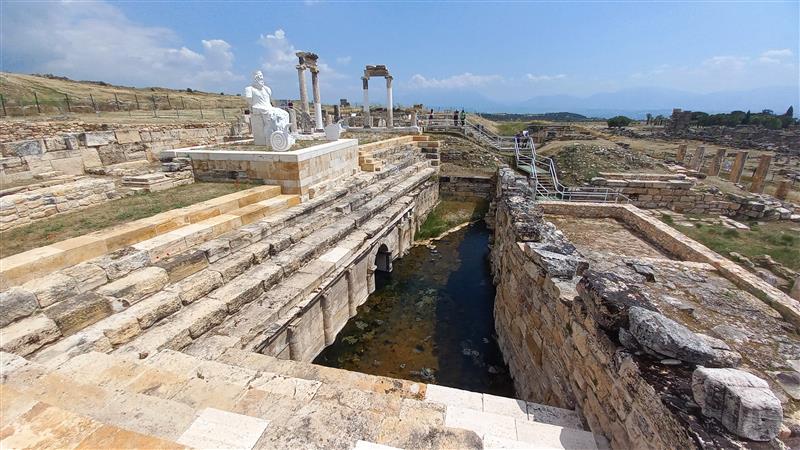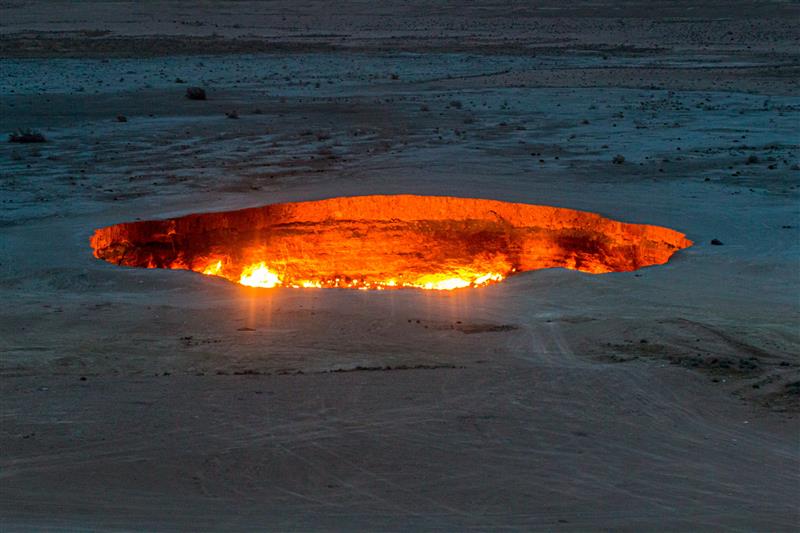There are many sites across the world that have been called “gates of hell”. Some of these strange subterranean places were believed to be actual doorways to the underworld, while others have earned their name due to their impressive geology, volcanic activity, sheer inaccessibility, or other features. Here are some examples of famous so-called gates of hell.
Pluto’s Gate, Turkey
The first on the list is the famous Pluto’s Gate, in the town of Pamukkale in southwestern Turkey. This site is an example of a ploutonion, a religious temple dedicated to the Chthonic god Pluto (Hades). The site was rediscovered and excavated in 2013, though hints about its existence were recorded in various historical sources.

Pluto’s Gate is located in the ruins of the Greco-Roman city of Hierapolis, which is in modern Turkey. The gases that issue from its interior are still deadly today.
Image credit: TheRunoman/Shutterstock.com
The temple was originally built with a gateway and surrounding arena that led into a cave. This cave was off-limits to visitors; only the priests were allowed to enter it. However, people could sit on raised seats and observe the priests conducting their ceremonies. These events took place at sunrise, when bulls would be led through the area towards the cave. Spectators could watch as the large animals started to struggle before they dropped dead, all while the priests remained unharmed.
It is now known that the cave is filled with gases that issue into the space from a fissure. Recent research indicates that the gas is volcanic carbon dioxide (CO2). The concentration of this gas varies depending on how close you are to the entrance and the ground, which may explain why Roman observers saw the bulls mysteriously die while the priests appeared unscathed.
Hell’s Gate, Kenya
In Kenya, Africa, there is the Hell’s Gate National Park, located in Nakuru County. It is situated between Lake Naivasha and the Longonot and Suswa volcanoes. The whole national park is famous for its breathtaking scenery, diverse wildlife – and, of course, its gate to hell. This is the name given to the Ol Jorowa Gorge which runs through the middle of the park.
The gorge was formed through a mix of volcanic processes and tectonic activity that has shaped the whole region over millions of years. Over time, water erosion has further carved out the gorge. Although it is unclear how it gained its evocative name, it is possibly due to the intense geothermal activity in the area. The gorge still has geysers and hot springs that issue hot volcanic water, which runs through the giant channel, providing sustenance to vegetation that can survive at high temperatures.
Darvaza crater, Turkmenistan
This is a modern and very much man-made gate to hell. In 1971, the Soviets were looking for oil fields in the Karakum Desert, in Turkmenistan. Although they initially thought they had struck liquid gold, they had actually tapped into something more unstable. Instead of drilling into oil, the Soviets had come across an enormous pocket of natural gas.
The rigging station they had set up to extract oil eventually collapsed, and created a giant hole – 70.1 meters (230 feet) across and 20.1 meters (66 feet) deep – that has become known as the Darvaza crater.

A photo taken at night of the Darvaza crater.
Image credit: Matyas Rehak/Shutterstock.com
Once the crater formed, it led to a cascading event whereby other craters appeared across the landscape. Worse still, all the craters issued methane, which was considered a hazard to local wildlife and communities. So in a misjudged effort to save the environment, a decision was made to set fire to the gas in the hope that it would quickly burn off. Unfortunately, this was not the case, as the fires have been blazing ever since, which has earned it the title of a “gate to hell“.
Batagaika slump, Siberia
The final example of a gate to hell is the Batagaika Crater, in Russia’s Far East. Like the Darvaza crater, this massive land feature is relatively new compared to other gates to hell. During the 1960s, scientists first reported what they called a “megaslump” when prolific deforestation in the Sakha Republic, Russia, disturbed the ground’s permafrost. This weakened it to the point where it collapsed.
Locals call the area the “Gateway to the Underworld”, and it’s evident why when you see the enormous 100-meter (328-foot) deep and around 1-kilometer (0.6-mile) long gash in the landscape. However, the Batagaika slump is not done with its hellish activity. Every year, the mega slump gets bigger. Some researchers have even suggested it may be expanding at a rate of 10 to 30 meters (33 to 98 feet) per year.
This expansion is attributed to climate change in the area, which is leading to warmer summers and shorter winters. Such conditions are unsustainable for the permafrost which continues to melt despite holding the ground together.
Source Link: Just How Many “Gates To Hell” Are There On Earth?